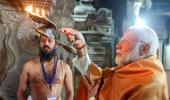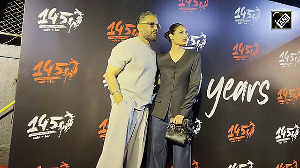The rulers of the day need to be sensitive and involved in managing the identities of sacred spaces and the ongoing dialogues about the past in diverse societies, suggests Colonel Nikhil Apte (retd).

'If you think that religion and politics aren't connected, then you don't understand either
--Mahatma Gandhi
History repeats itself. May not be in exact terms but it almost always does.
As India woke up to a new dawn and the consecration (pran pratishtha) of the Ram Lalla idol at a newly built temple in Ayodhya, one wonders if there is an historical parallel to this event.
Has an event such as this happened before, where a religious site usurped by the invaders is reclaimed by the original believers after hundreds of years?
Have religious sites of great importance been repurposed and changed allegiances through the change of political fortunes?
Ram Janmabhoomi
The Ram Janmabhoomi-Babri Masjid site lies in Ayodhya, Uttar Pradesh.
Ayodhya is considered by Hindus as the birthplace of Lord Ram, a revered deity in Hinduism.
Babur, a descendant of Timur on his father's side and Genghis Khan on his mother's side, successfully invaded India in 1526.
He started the Mughal dynasty in India and ruled from Delhi. During his rule, he destroyed the temple at the birthplace of Lord Ram, and built a mosque atop this temple.
This mosque was name after him as the Babri Masjid.
The 20th century saw a series of legal battles and protests, ultimately culminating in the demolition of the Babri Masjid on December 6, 1992, by a mob of Hindu activists.
The aftermath of the incident has continued to shape Indian politics and society, with the dispute ultimately reaching resolution through a Supreme Court verdict in 2019.
The court ordered the construction of a Hindu temple at the disputed site while allocating an alternative piece of land for the construction of a mosque.
On Monday, the prime minister of India consecrated the idol of Ram Lalla in the newly built temple bringing closure to an episode which has spanned almost 500 years.
Cathedral of Cordoba in Spain
The history of the site where the Cathedral of Cordoba stands is a subject of historical debate, and different narratives exist.
After the successful Muslim conquest of Spain, the mosque of Cordoba was built in the 8th century by the Umayyad Caliphate.
Before the Umayyad Caliphate constructed the mosque, the Visigothic Christian rulers had a church on the same site dedicated to Saint Vincent.
The Visigothic Church may itself have been built on the site of a Roman temple.
After the Muslim forces captured Cordoba in 711, the church was converted to a mosque. The construction of the mosque incorporated elements from a pre-existing Visigothic church.
Following the Christian reconquest of Spain, the mosque was converted into a cathedral in the 13th century.
The integration of Christian elements into the existing Islamic structure led to the creation of a unique blend of architectural styles, known as the Mosque-Cathedral of Cordoba.
Despite this synthesis, controversies exist over the years regarding the rightful ownership and use of the site.
The dual identity of the Cathedral of Cordoba continues to be a topic of discussion, raising questions about the preservation of cultural heritage and the representation of religious diversity in contemporary Spain.
The Hagia Sophia in Turkey
The Hagia Sophia, originally known as the Church of the Holy Wisdom (Ayasofya in Turkish), is a historic architectural marvel located in Istanbul, Turkey.
Its history spans over a millennium, and it has served various religious purposes over the centuries.
The Hagia Sophia was commissioned by the Byzantine Emperor Justinian I and inaugurated in December, 537 AD.
It was itself built on the site of two earlier churches. For nearly 1,000 years, the Hagia Sophia served as the principal cathedral of the Eastern Orthodox Church and was considered the center of Orthodox Christianity.
In 1453, the Ottoman Empire, under Sultan Mehmed II, conquered Constantinople (modern-day Istanbul), marking the end of the Byzantine Empire. The Hagia Sophia was then converted into a mosque.
The Ottomans made several architectural alterations, including the addition of minarets, removal of Christian iconography, and the installation of Islamic features.
After the fall of the Ottoman Empire and the establishment of the Republic of Turkey, President Kemal Ataturk moved the nation towards secularization.
In 1935, the Turkish government, transformed the Hagia Sophia into a museum as part of broader efforts to secularise Turkey.
Then, much recently, in July, 2020, Turkish President Recep Tayyip Erdoğan signed a decree converting the Hagia Sophia back into a mosque.
Following the conversion, the Hagia Sophia reopened as a mosque, allowing Muslim worshipers to use the space for prayers.

Epilogue
In all three cases, the conversion and reconversion of religious sites reflect the influence of different religious communities and rulers over time.
The transitions often mirror the changing political and religious landscapes in the respective regions.
Irrespective of the forms of government, political factors played a significant role in the conversion and reconversion of these sites.
Whether during the Mughal rule in India, the Reconquista in Spain, or the secularization efforts in Turkey, political decisions have shaped the destiny of these sacred spaces.
The political flavour of prevailing times dictated the appropriation of the religious sites.
Whether it was the fervour of an all conquering religion, the advent of leftist ideology in the early 20th century or the indigenous rightist political tilt in present times, political actors have always used religion to align their politics to the people they represent.
The controversies surrounding the conversion and reconversion of religious sites underscore the challenges of preserving cultural heritage and accommodating diverse historical narratives.
The delicate balance between respecting the heritage of multiple communities and avoiding religious or cultural exclusion remains a key challenge.
The conversion and reconversion of religious sites are intricate processes shaped by a myriad of historical, political, and cultural factors.
The rulers of the day need to be sensitive and involved in managing the identities of sacred spaces and the ongoing dialogues about the past in diverse societies.
Colonel Nikhil Apte left the Indian Army in December 2019 after 20 years service.
While in service besides unit command and other instructional appointments, he has been a staff officer in the Military Operations Directorate on the AF-Pak desk.
His last assignment was as a faculty at Staff College, Wellington.
Feature Presentation: Aslam Hunani/Rediff.com










